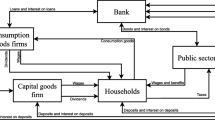Abstract
The dynamics of inequality are studied in a model of human capital accumulation with credit constraints. This model admits a multiplicity of steady state skill ratios that exhibit varying degrees of inequality across households. The main result studies equilibrium paths. It is shown that an equilibrium sequence of skill ratios must converge monotonically to the smallest steady state that exceeds the initial ratio for that sequence. Convergence is “gradual" in that the steady state is not achieved in finite time. On the other hand, if the initial skill ratio exceeds the largest steady state, convergence to a steady state is immediate.
Similar content being viewed by others
References
Aghion P., Bolton P. (1997). A theory of trickle-down growth and development. Rev Econ Stud 64, 151–172
Bandyopadhyay D. Distribution of human capital, income inequality and rate of growth, PhD thesis, University of Minnesota (1993)
Banerjee A., Newman A. (1993). Occupational choice and the process of development. J Political Econ 101, 274–298
Becker G., Tomes N. (1979). An equilibrium theory of the distribution of income and intergenerational mobility. J Political Econ 87, 1153-1189
Bewley T. (1982). An integration of equilibrium theory and turnpike theory. J Math Econ 10, 233–267
Champernowne D. (1953). A model of income distribution. Econ J 63, 318–351
Clark C. (1971). Economically optimal policies for the utilization of biologically renewable resources. Math Biosci 12, 245–260
Coles J. (1985). Equilibrium turnpike theory with constant returns to scale and possibly heterogeneous discount factors. Int Econ Rev 26, 671–679
Dechert W.D., Nishimura K. (1983). A complete characterization of optimal growth paths in an aggregated model with a non-concave production function. J Econ Theory 31, 332–354
Freeman S. (1996). Equilibrium income inequality among identical agents. J Political Econ 104(5): 1047–1064
Galor O., Zeira J. (1993). Income distribution and macroeconomics. Rev Econ Stud 60(1): 35–52
Ghatak M., Jiang N. (2002). A simple model of inequality, occupational choice and development. J Dev Econ 69, 205–226
Ljungqvist L. (1993). Economic underdevelopment: the case of missing market for human capital. J Dev Econ 40, 219–239
Loury G.C. (1981). Intergenerational transfers and the distribution of earnings. Econometrica 49, 843–867
Majumdar M., Mitra T. (1982). Intertemporal allocation with a non-convex technology: the aggregative framework. J Econ Theory 27, 101–136
Majumdar M., Mitra T. (1983). Dynamic optimization with a non-convex technology: the case of a linear objective function. Rev Econ Stud 50, 143–151
Mani A. (2001). Income distribution and the demand constraint. J Econ Growth 6, 107–133
Matsuyama K. (2000). Endogenous inequality. Review of Economic Studies 67, 743–759; Constraint. J Econ Growth 6, 107–133
Mookherjee D., Ray D. (2002). Is equality stable?. Am Econ Rev 92, 253–259
Mookherjee D., Ray D. (2003). Persistent inequality. Rev Econ Stud 70, 369–393
Piketty T. (1997). The dynamics of the wealth distribution and the interest rate with credit rationing. Rev Econ Stud 64, 173–189
Ray, D.: Income distribution and macroeconomic behavior. Mimeo, New York University, http://www.econ.nyu.edu/user/debraj/DevEcon/Notes/incdist.pdf (1990)
Ray D., Streufert P. (1993). Dynamic equilibria with unemployment due to undernourishment. Econ Theory 3, 61–85
Rigolini J. (2004). Educational technologies, wages, and technological progress. J Dev Econ 75, 55–77
Tanaka, R.: Timing of trade liberalization. Mimeo, Department of Economics, New York University (2003)
Yano M. (1984). The turnpike of dynamic general equilibrium paths and its insensitivity to initial conditions. J Math Econ 13, 235–254
Author information
Authors and Affiliations
Corresponding author
Additional information
This paper is based on unpublished notes from 1990; see http://www.econ.nyu.edu/user/debraj/DevEcon/Notes/incdist.pdf. Two considerations suggest that these results may be worth reporting in print. First, the existence of a sizeable recent literature indicates that these relatively early notes may have value outside a filing cabinet or a private webpage. Second, Mukul Majumdar’s own research on economic growth with a nonconvex technology is an even earlier precursor to some of this literature, so the current outlet – a special issue in his honor – seems appropriate. Conversations with Glenn Loury simplified the proof of the main result. I thank Dilip Mookherjee for many useful discussions, and two anonymous referees for helpful comments on an earlier draft. Funding from the National Science Foundation under grant number 0241070 is acknowledged. This paper is dedicated with much affection and warm admiration to Mukul Majumdar – or to Mukulda, as I always think of him – on the occasion of his 60th birthday.
Rights and permissions
About this article
Cite this article
Ray, D. On the dynamics of inequality. Economic Theory 29, 291–306 (2006). https://doi.org/10.1007/s00199-005-0021-2
Received:
Accepted:
Published:
Issue Date:
DOI: https://doi.org/10.1007/s00199-005-0021-2




